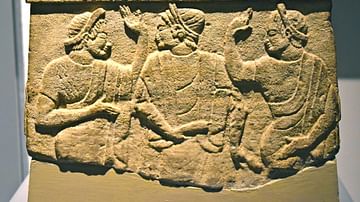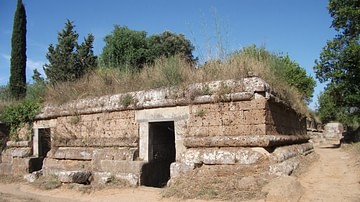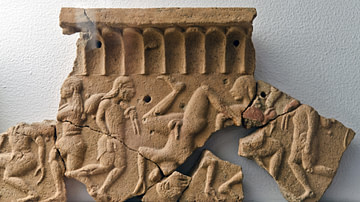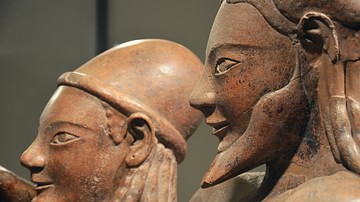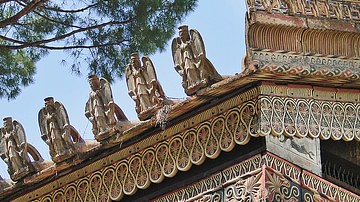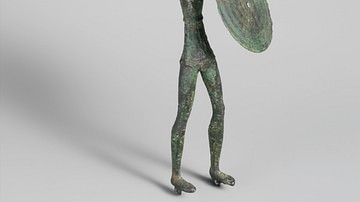
The language of the Etruscans, like the people themselves, has remained somewhat mysterious and has yet to be fully understood. The alphabet used a western Greek script, but the language has presented difficulties to scholars because it is unrelated to contemporary Indo-European languages and the surviving examples of it are largely limited to very short inscriptions, the majority of which are proper names. Letters, pronunciation, general sentence structure and many proper nouns are generally understood, but the meaning of many more words which can not be inferred from context, loan words in other languages, and appearance in parallel texts, etc. remain the biggest stumbling block to fully deciphering the language. What is clearer from the vast number of surviving inscriptions is that a limited literacy was relatively common, including amongst women, and was widespread over the whole of Etruria.
Origins & Sources
Etruscan was a relatively isolated language not connected with the Indo-European languages of Italy, and with only two known related languages considered to have derived from the same common parent source. These are Raetic, spoken in the alpine region north of Verona, and the language spoken on Lemnos before Greek, both with very limited surviving text examples, and the latter probably derived from Etruscan traders. It seems that the 1st-century BCE historian Dionysius of Halicarnassus was entirely justified in claiming that the Etruscans were "a very ancient people resembling no other either in language or customs" (Heurgon, 1). Etruscan was spoken throughout Etruria, that is western central Italy from Rome in the south to the Po River Valley in the north where the Etruscans founded colonies.
There are over 13,000 individual examples of Etruscan text, which cover the major period of the civilization from the 8th to 1st century BCE. Most are from Etruria itself, but there are additional sources from southern and northern Italy, Corsica, and North Africa. The texts take the form of, mostly short and often fragmentary, inscriptions on pottery and metal or stone tablets. One of the most important and useful are the three gold sheet tablets from Pyrgi, the port of Cerveteri, which had the same information (albeit in a different context) in both Etruscan and the Phoenician alphabet. Discovered in the foundations of a temple and dating to c. 500 BCE, it describes a dedication of a sacred area to Astarte and was probably once pinned to the temple wall.
Artworks and such everyday objects as mirrors, weapons and armour, especially those left as votive offerings at sanctuaries are another source. A typical example of these short snippets of text is the following from a small terracotta flask:
Aska mi eleivana, mini mulvanike mamarce velchana
(I am an oil bottle and Mamarce Velchana donated me)
Pottery, funerary urns and wall paintings in tombs frequently carry short inscriptions, too. Unfortunately, there are very few surviving extensive written records and no books written by the Etruscans in their own language, although it is known that the Etruscans did create books made of folded linen pages (liber linteus), and those extracts which do survive point to a rich Etruscan literature. One example, with around 1500 words, the longest surviving text, survives indirectly and incompletely as the binding of an Egyptian mummy in the National Museum of Zagreb. It described various ritual procedures and ceremonies dictated by the calendar used in the Etruscan religion.
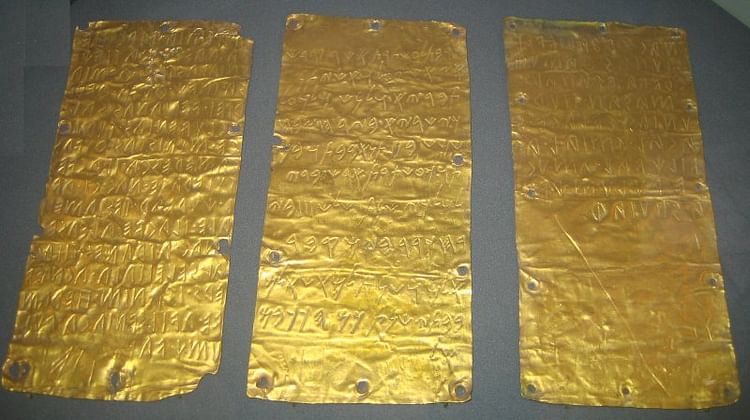
Sometimes archaeologists get lucky and a single find proves invaluable – in this case, a small 7th-century BCE ivory tablet from Marsiliana d'Albegna which had been used as a wax writing tablet and had the complete alphabet engraved on the side, no doubt, as a memory aid for its owner. Another great find was a bucchero pottery cockerel from Viterbo which also had a complete alphabet scratched onto its surface.
A second indirect source is the glossaries of Greek and Latin writers who translated lists of Etruscan words into their own language. Another important aid to linguists is the use of loan words in a second language, and here Latin and Greek are again helpful. Finally, the archaeological context of inscriptions can provide information useful to their general meaning.
Alphabet & Structure
The Etruscan alphabet was adapted from a western Greek one, in all probability introduced by traders from Euboea sometime before 700 BCE, and so its pronunciation is generally known. With this Greek contact, new words were required for new objects arriving in the Etruscan world, and these show a marked similarity to their Greek originals. For example, pottery was imported into Etruria in large quantities, and such peculiar vessels as the Greek jug or two-handled stemmed cup, the prochous and lekythos, become pruchum and lechtum, respectively. Such assimilation is seen again in mythology where Greek figures are given Etruscanised names, e.g. Aias or Ajax becomes Eivas and Herakles or Hercules becomes Ercle.
The Etruscan alphabet had 26 signs, but some were not used; these were Greek without a corresponding sound in the spoken Etruscan (e.g. beta, gamma, delta, and omikron). Similarly, some letters were added to cover Etruscan sounds not present in Greek (e.g. 8 for the F-sound). There were only four vowels (a, e, i, u) and, with predominantly the word stress occurring on the first syllable, short internal ones were abandoned from the 5th century BCE, resulting in frequent consonant clusters. Texts were read from right to left, although longer ones could take alternate directions on each line (boustrophedon).

There is an indication of tense use, but such features as indicators of differences in noun numbers have not yet been identified. Sentence structure remains unclear, but a subject-object-verb sequence seems to prevail. The largest hole in linguists' knowledge of Etruscan is vocabulary as only around 200 words which are not proper nouns survive. For this reason, it is not inconceivable that further archaeological discoveries will expand this lexicon and give linguists a greater chance of fully understanding Etruscan.
Legacy
The Etruscans, as they colonised parts of northern Italy, spread their alphabet to the Veneti, Raetians, and Lepontians, amongst others. They also traded with peoples from the other side of the Alps, and so passed on their alphabet and language to Germanic tribes which would lead to the development of the Runic script of northern Europe.
The Etruscans were conquered by the Romans in the 2nd and 1st century BCE, and much of their culture assimilated into new Roman ways. Etruscan gradually disappeared as a daily language, replaced by Latin as seen on monument inscriptions of that period, but it seems to have survived in more formal contexts for Tyrrhenian hymns are referred to by the 1st-century CE Latin author Lucretius, and it is known that some Etruscan religious rites and practitioners survived into the Imperial period when they likely still used Etruscan formulas and phrases. In addition, just as the Romans continued some of the cultural practices of the Etruscans so too Latin adopted many words from the language of Italy's first great civilization. Finally, there are those who see the famous Tuscan burr, or gorgia toscana, of modern Italians in that region as an inheritance from their Etruscan forefathers.
